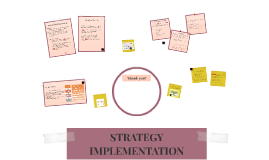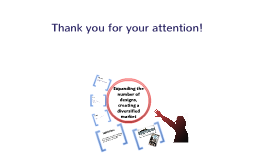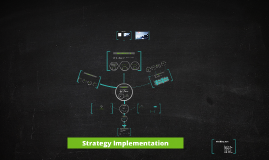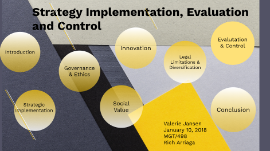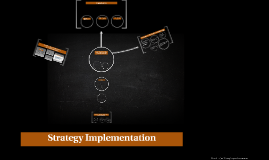STRATEGY IMPLEMENTATION
Transcript: it outlines... (1) the major steps required to reach an objective, (2) the organization unit or member responsible for each step (3) the order and timing of each step. 1. They interpret strategy, acting as final judges when managers disagree on implementation. 2. CEOs enact through their words and actions the seriousness of an organization’s commitment to a strategy. 3.CEOs motivate, providing intangible incentives beyond pay or bonuses. By appealing to members’ values, beliefs, and loyalties, CEOs can mobilize support for a strategy. Institutionalizing Strategy - McKinsey & Co. (1) Commitment to the programs (2) Top level goal setting (3) Individual goals (4) Participants (5) Autonomy in implementation of plans (6) Performance review Operationalizing Strategy Projects - smaller, separate portions of programs; they are limited in scope and contain distinct directives concerning assignments and time. Reward System Thank you! THE SEVEN-S MODEL The role of the CEO Many employees are motivated by two goals: earning a paycheck and doing work that makes them proud. -detailed courses of action that probably will not be repeated in the same form in the future SINGLE-USE PLANS MANAGEMENT BY OBJECTIVE When is a strategy institutionalized? -if it is connected to the culture, the quality system, and the other driving forces in the organization. Standard Operating Procedures or Standard Methods -detailed procedures that accompany policies -detailed set of instructions for performing a sequence of actions that occurs often or regularly. Rules - statements of specific actions to be taken in a given situation first outlined by Peter Drucker and then developed by George Odiorne, his student, was popular in the 1960s and 1970s. Management:James Arthur Finch Stoner, R. Edward Freeman The Connection Between Strategy and Structure: Stanley Kavale http://www.ijbcnet.com/1-6/ijbc-12-1606.pdf http://smallbusiness.chron.com/role-reward-employee-motivation-18814.html STRATEGY IMPLEMENTATION -are specific, measurable statements of what an organization subunit is expected to achieve in contributing to the accomplishment of the business's grand strategy. -a systematic and organized approach that allows management to focus on achievable goals and to attain the best possible results from available resources References operational plans provide the details needed to incorporate strategic plans into the organization’s day to day operations. The role of the CEO: -Chief Executive Officers (CEOs) spend most of their time developing and guiding strategy, -their personal goals and values inevitably shape organizational strategy -their role in strategy formulation makes CEOs especially important to strategy implementation. Budgets - statements of financial resources set aside for specific activities in a given period of time; -they are primarily devices to control an organization’s activities, and thus are important components of programs and projects. STANDING PLANS 1. represent the basis for allocating resources, 2. are a primary mechanism for evaluating managers, 3. are the major instrument for monitoring progress towards achieving long-term objectives, and 4. establish organizational, divisional and departmental priorities. -Alfred Chandler -a pre-established single decision or set of decisions can effectively guide those orgabizational activitis that occur repeatedly. -once established such standing plans help managers conserve time because similar situations are handled in a pre-determined, consistent manner. Elements of MBO System Annual Objectives Institution -collection of values, norms, roles, and groups that develops to accomplish a certain goal. Policy - a general guideline for decision making. - it sets up boundaries around decisions. - it channels the thinking of organization members so that it is consistent with organizational objectives. CHANDLER'S THESIS The offer of an additional reward gives an employee that extra motivation to go above and beyond. Program - covers a relatively large set of activities. -implies that every organizational structure is mainly developed based on the strategy of the organization and therefore successful implementation of an organization‘s strategy will depend on the firm‘s primary organizational structure. "Structure follows Strategy" Incentive According to Microsoft's Business website, a policy that offers incentives in exchange for achievement can motivate all employees to prove their worth. Uniting the Team Employees are motivated by a workplace atmosphere of mutual respect. Employee Retention An employee who has been rewarded is often more motivated to remain with the company. Self-Motivation According to Carter McNamara, writing for the Free Management Library, the most effective rewards are tailored to an employee's needs. When deciding what kind of rewards to give to employees, think of their needs.






